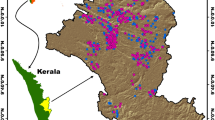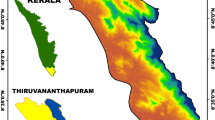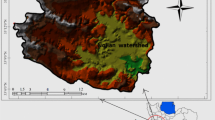Abstract
The Gangtok subdivision in east Sikkim district was developed under different geographical, lithological, and historical conditions. This research aimed towards creating a landslide susceptibility zone with the help of two GIS models, namely AHP (analytical hierarchy process) and FRM (frequency ratio model), used for landslide susceptibility mapping and make a comparison in accordance with their outputs. Primary data like the landslide location was collected by using the GPS technique and BHUVAN landslide inventory, while, photographic data were collected from various satellite images and theme-based images from BHUVAN, ENVIS, and Earth Explorer. Other secondary data were collected from the Survey of India (SOI), National Bureau of Soil Survey, Geological Survey of India, NRSC, India, and land use planning (NBSS&LUP), Census of India and Indian Meteorological Department. Eleven thematic layers including landslide inventory, rainfall, lithology, geomorphology, slope, aspect, curvature, distance from lineament, distance from the road, distance from drainage, and land use/land cover, were considered for the FRM method and the AHP method. AHP map captures 80% of the active slides in the very high to the high susceptible zones in comparison to the 75% active slide capture by the FRM method in the very high to high susceptible zone. For validation and comparison of the model output, the receiver operating curve (ROC) was applied to 30% cases out of the 100% of total landslides (92 landslide locations were marked). AHP method was found out to be the best among the two models with a 98% accuracy level. The risk mapping was done by integrating exposure map with hazard map along with physical vulnerability map of the study area. Through risk mapping it is seen that the eastern section of the study area has the least risk but on the contrary, the western zone is the riskier zone for landslide hazard. There has been also an attempt to find out plausible methods for landslide disaster management and mitigation for the study area.
Similar content being viewed by others
References
Abedini, M. and Tulabi, S. (2018) Assessing LNRF, FR, and AHP models in landslide susceptibility mapping index: a comparative study of Nojian Watershed in Lorestan Province, Iran. Environ. Earth Sci. v.77(11), pp.1–13. doi:https://doi.org/10.1007/s12665-018-7524-1
Aghdam, I.N., Varzandeh, M.H.M. and Pradhan, B. (2016) Landslide susceptibility mapping using an ensemble statistical index (Wi) and adaptive neuro-fuzzy inference system (ANFIS) model at Alborz Mountains (Iran). Environ. Earth Sci., v.75(7), pp.1–20. doi:https://doi.org/10.1007/s12665-015-5233-6
Akgun, A. (2012): A comparison of landslide susceptibility maps produced by logistic regression, multi-criteria decision, and likelihood ratio methods: a case study at Izmir, Turkey. Landslide, v.9, pp.93–106.
Akgun, A., Dag, S. and Bulut, F. (2008) Landslide susceptibility mapping for a landslide-prone area (Findikli, NE of Turkey) by likelihood frequency ration and weighted linear combination models. Environ. Geol., v.54, pp.1127–1143.
Ayalew, L., Yamagishi, H., Marui, H. and Kanno, T. (2005) Landslides in Sado Island of Japan: part II. GIS-based susceptibility mapping with comparisons of results from two methods and verifications. Engg., Geol., v.81, pp.432–445.
Ayalew, L., Yamagishi, H. and Ugawa, N. (2004) Landslide susceptibility mapping using GIS based weighted linear combination, the case in Tsugawa area of Agano River, Niigata Prefecture, Japan. Landslides, v.1, pp.73–81
Bahrami Y, Hassani H, Maghsoudi A (2020) Landslide susceptibility mapping using AHP and fuzzy methods in the Gilan Province, Iran. GeoJournal, pp.1–20. doi:https://doi.org/10.1007/s10708-020-10162-y
Banerjee, P., Ghose, M.K. and Pradhan, R. (2018) Analytic hierarchy process and information value method-based landslide susceptibility mapping and vehicle vulnerability assessment along a highway in Sikkim Himalaya. Arab. Jour. Geosci., v.11, pp.139.
Bathrellos, G.D., Skilodimou, H.D., Chousianitis, K., Youssef, A.M. and Pradhan, B., (2017) Suitability estimation for urban development using multi-hazard assessment map. Sci. Total Environ., v.575, pp.119–134.
Biswas, B., Vignesh, K.S. and Ranjan, R. (2021) Landslide susceptibility mapping using integrated approach of multi-criteria and geospatial techniques at Nilgiris district of India. Arab. Jour. Geosci., v.14, 980. doi:https://doi.org/10.1007/s12517-021-07341-7.
Bonham-Carter, G.F. (1994) Geographic information systems for geoscientists, modeling with GIS. Pergamon Press, Oxford, 398p.
Catani, F., Casagli, N., Ermini, L., Righini, G., & Menduni, G. (2005) Landslide hazard and risk mapping at catchment scale in the Arno River basin. Landslides, v.2(4), pp.329–342.
Chanda, Arunima (2019) Impact of natural hazards on socioeconomic condition of population of Sikkim, PhD thesis, Jamia Millia Islamia, New Delhi.
Chung, C.J. and Fabbri, A.G. (1999) Probabilistic prediction models for landslide hazard mapping. Photogramm. Eng. Rem., Sens., v.65(12), pp.1389–1399.
Ercanoglu, M. and Gokceoglu, C., (2004) Use of fuzzy relations to produce landslide susceptibility map of a landslide prone area (West Black Sea Region, Turkey). Engg. Geol., v.75 (3–4), pp.229–250.
Erener, A. and Düzgün H.S.B. (2010) Improvement of statistical landslide susceptibility mapping by using spatial and global regression methods in the case of More and Romsdal (Norway). Landslides, v.7, pp.55–68.
Feizizadeh, B., Blaschke, T., Nazmfar, H., Rezaei and Moghaddam, M., (2013) Landslide susceptibility mapping for the Urmia Lake basin, Iran: a multi-criteria evaluation approach using GIS. Int. Jour. Environ. Res., v.7, pp.319–336.
Gupta, R.P. and Joshi, B.C. (1990) Landslide Hazard Zonation Using the GIS Approach—A Case Study from the Ramganga Catchment, Himalayas. Engg. Geol., v.28, pp.119–131. doi:https://doi.org/10.1016/0013-7952(90)90037-2
Hepdeniz, K. (2020) Using the analytic hierarchy process and frequency ratio methods for landslide susceptibility mapping in Isparta-Antalya highway (D-685), Turkey. Arab. Jour. Geosci., v.13, pp.795.
Hongjie Chen, Guangcheng Zhang, Zheng Chang, Lian Wen, Wentao Gao (2021) Failure Analysis of a Highway Cut Slope with Anti-Slide Piles. Geofluids, v.2021, 6622214, 15p., doi:https://doi.org/10.1155/2021/6622214
Jadda, M., Shafri, H.Z.M., Mansor, S.B., Sharifikia, M., Pirasteh, S. (2009) Landslide susceptibility evaluation and factor effect analysis using probabilistic-frequency ratio model. European Jour. Sci. Res., v.33, pp.654–668.
Kanungo, D.P., Arora, M.K., Gupta, R.P. and Sarkar, S. (2008) Landslide risk assessment using concepts of danger pixels and fuzzy set theory in Darjeeling Himalayas. Landslides, v.5(4), pp.407–416.
Komac, M., (2006) A landslide susceptibility model using the analytical hierarchy process method and multivariate statistics in perialpine Slovenia. Engg. Geol., v.76 (1–2), pp.109–128.
Lee, S., Choi, J. and Min, K. (2004) Probabilistic landslide hazard mapping using GIS and remote sensing data at Boun, Korea. Internat. Jour. Remote Sens., v.25(11), pp.2037–2052.
Lee, S. and Dan, NT., (2005) Probabilistic landslide susceptibility mapping in the Lai Chau province of Vietnam: Focus on the relationship between tectonic fractures and landslides. Environ. Geol., v.48(6), pp.778–787.
Lee, S. and Min, K. (2001) Statistical analysis of landslide susceptibility at Yongin, Korea. Environ. Geol., v.40, pp.1095–1113.
Lee, S. and Pradhan, B. (2007) Landslide hazard mapping at Selangor, Malaysia using frequency ratio and logistic regression models. Landslides, v.4, pp.33–41.
Lee, S. and Sambath, T. (2006) Landslide susceptibility mapping in the damreiromel area, cambodia using frequency ratio and logistic regression models. Environ. Geol., v.50, pp.847–855.
Lee, S. and Talib, JA. (2005) Probabilistic landslide susceptibility and factor effect analysis. Environ. Geol,, v.47(7), pp.982–990.
Mersha, T. and Meten, M. (2020) GIS-based landslide susceptibility mapping and assessment using bivariate statistical methods in Simada area, northwestern Ethiopia. Geoenviron Disasters, v.20(7), doi:https://doi.org/10.1186/s40677-020-00155-x
Prabnakorn, S., Maskey, S. and Suryadi, F.X., (2019) Assessment of drought hazard, exposure, vulnerability, and risk for rice cultivation in the Mun River Basin in Thailand. Nat. Hazards, v.97, pp.891–911. doi:https://doi.org/10.1007/s11069-019-03681-6
Qiao, G., Lu, P., Scaioni, M., Xu, S., Tong, X., Feng, T., Wu, H., Chen, W., Tian, Y., Wang, W. and Li, R. (2013) Landslide Investigation with Remote Sensing and Sensor Network: From Susceptibility Mapping and Scaled-down Simulation towards in situ Sensor Network Design. Remote Sens., v.5, pp.4319–4346.
Razak, K.A., Straatsma, M.W., Van Westen, C.J., Malet, J.P. and de Jong, S.M. (2011) Airborne laser scanning of forested landslides characterization: terrain model quality and visualization. Geomorphology, v.126, pp.186–200.
Rozos, D., Bathrellos, G.D., Skilodimou, H.D., (2011) Comparison of the implementation of rock engineering system and analytic hierarchy process methods, upon landslide susceptibility mapping, using GIS: a case study from the Eastern Achaia County of Peloponnesus, Greece. Environ. Earth Sci., v.63, pp.49–63.
Saaty, T.L. (1980) The Analytical Hierarchy Process. McGraw Hill, New York.
Saaty, T.L. (1977) A scaling method for priorities in hierarchical structures. Jour. Math. Psychol., v.15, pp.234–281.
Saaty, T.L. and Vargas, L.G., (1984) Inconsistency and rank preservation. Jour. Math. Psychol., v.28, pp.205–214.
Saaty, T.L. and Vargas, L.G., (1991) Prediction, Projection, and Forecasting: Applications of the Analytical Hierarchy Process in Economics, Finance, Politics, Games, and Sports. Kluwer Academic Publishers, Boston.
Sahnoun, H., Serbaji, M.M., Karray, B. and Medhioub, K., (2012) GIS and multi-criteria analysis to select potential sites of agro-industrial complex. Environ. Earth Sci., v.66, pp.2477–2489.
Scaioni, M., Lu, P., Chen, W., Qiao, G., Wu, H.; Feng, T., Tong, X., Wang, W. and Li, R. (2013) Analysis of spatial sensor network observations during landslide simulation experiments. European Jour. Environ. Civil. Eng. doi: https://doi.org/10.1080/19648189.2013.822427.
Shahabi, H. and Hashim, M. (2015) Landslide susceptibility mapping using GIS based statistical models and remote sensing data in tropical environment. Sci. Rep., 5:9899. doi:https://doi.org/10.1038/srep09899
Siddique, T. and Khan, E.A. (2019) Stability appraisal of road cut slopes along a strategic transportation route in the Himalayas, Uttarakhand, India. SN Appl. Sci., v.1, 409. doi:https://doi.org/10.1007/s42452-019-0433-4
Skilodimou, H.D., Bathrellos, G.D., Chousianitis, K., Youssef, A.M. and Pradhan, Â., (2019): Multi-hazard assessment modeling via multi-criteria analysis and GIS: A case study. Environ. Earth Sci., v.78(2), pp.47.
SSDMA. Inventory and GIS Mapping of landslides in North East West and South Sikkim and its Mitigation. Gangtok: UNDP, NDMA, 2015.
Voogd, H. (1983) Multicriteria Evaluation for Urban and Regional Planning. Pion, London.
Yalcin, A. (2008) GIS-based landslide susceptibility mapping using analytical hierarchy process and bivariate statistics in Ardesen (Turkey): comparisons of results and confirmations. Catena, v.72, pp.1–12.
Yalcin, A., Reis, S., Aydinoglu, A. and Yomralioglu, T. (2011) A GIS-based comparative study of frequency ratio, analytical hierarchy process, bivariate statistics and logistics regression methods for landslide susceptibility mapping in Trabzon, NE Turkey. Catena, v.85, pp.274–287.
Yilmaz, I. (2009) Landslide susceptibility mapping using frequency ratio, logistic regression, artificial neural networks and their comparison: A case study from Kat landslides (Tokat-Turkey). Computer. Geosci., v.35, pp.1125–1138.
Youssef, A.M., Pradhan, B. and Tarabees, E., (2011) Integrated evaluation of urban development suitability based on remote sensing and GIS techniques: contribution from the analytic hierarchy process. Arab. Jour. Geosci., v.4, pp.463–473.
Author information
Authors and Affiliations
Corresponding author
Rights and permissions
About this article
Cite this article
Biswas, B., Rahaman, A. & Barman, J. Comparative Assessment of FR and AHP Models for Landslide Susceptibility Mapping for Sikkim, India and Preparation of Suitable Mitigation Techniques. J Geol Soc India 99, 791–801 (2023). https://doi.org/10.1007/s12594-023-2386-x
Received:
Accepted:
Published:
Issue Date:
DOI: https://doi.org/10.1007/s12594-023-2386-x




